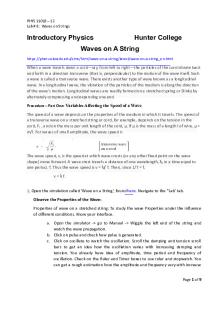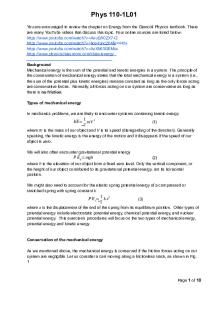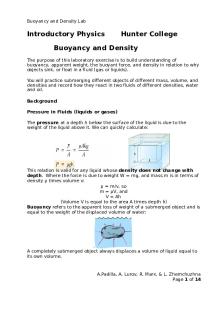N.Gonzales PHYS 1101 Lab 1 - Virtual Measurement of Density-1 PDF

| Title | N.Gonzales PHYS 1101 Lab 1 - Virtual Measurement of Density-1 |
|---|---|
| Course | Intro Physics: Mechanics |
| Institution | Southern New Hampshire University |
| Pages | 5 |
| File Size | 213.1 KB |
| File Type | |
| Total Downloads | 85 |
| Total Views | 117 |
Summary
Download N.Gonzales PHYS 1101 Lab 1 - Virtual Measurement of Density-1 PDF
Description
Nancy Gonzales PHYS 1101-001
Virtual Measurement of Density Theory: The density of an object is a measure of the mass per unit volume. D=
m , the units are in g/cm3, g/mL, kg/m3 depending upon the V
material. Procedure: Run the simulation https://www.simbucket.com/density/ 1. 2. 3. 4. 5.
Make sure the Fluid is set to water: Density of water is 1g/mL. Select a material, start with Gold. Record name of material in the table. Mass the material by putting in on the scale. Record the mass in the table. Note the volume of water in the beaker. Record as initial volume in the table. Place the material into the beaker. Note the new volume of water in beaker and record as final volume in the table. 6. Select a new material and repeat steps 3 – 6. Make sure that the material completely submerges. If not select new material.
Material
Mass (g)
V(initial) mL
V(final) mL
Gold Lead Iron Rubber ?????
40.53 g 72.32 g 31.48 g 0.52 g 18.58 mL
25.5 mL 25.5 mL 25.5 mL 25.5 mL 25.5 mL
27.6 mL 31.9 mL 29.5 mL 25.9 mL 31.2 mL
ΔV mL
2.1 6.4 4 0.4 5.7
Density g/mL 19.3 11.3 7.87 1.3 3.26
Accepted Value g/mL 19.3 11.3 7.87 1.2 3.26
% Error
0% 0.44% 0% 8.33% 0%
|Accepted− Experimental|
% Error=
Accepted Value
∗100 %
Calculations: Include your calculations for each density, and for each % Error. (If you can’t put calculations into the word document, write the calculations out and insert a picture of your work).
Nancy Gonzales PHYS 1101-001
Percent Error: Gold: 19.3-19.3/19.3=0 x 100%= 0% Lead: 11.35-11.3/11.4=0.044 x 100%= 0.44% Iron: 7.87-7.87/7.87=0 x 100%= 0% Rubber: 1.2-1.3/1.2=0.08 x 100%= 8.33% ???? Diamond: 3.26-3.26/3.26=0 x 100%= 0% Questions: 1. Look up the definition of a Liter. How is a milliliter related to a cubic centimeter? A liter is a metric unit of capacity, formerly defined as the volume of one kilogram of water under standard conditions, now equal to 1,000 cubic centimeters. A milliliter measures fluid amounts and cubic centimeters measure solid amounts. They are both the same measurement, but just measure fluid and solids. 2. The density of water is 1 g/cm3 or 1 g/mL. Show that this is equivalent to 1000 kg/m3. The density of water is 1 g/mL and this is equivalent to 1000 kg/m because the ratios are still the same even though it’s a bigger number. All we are doing is cancelling the units to get 1000 kg/m from 1 g/mL. 3. Are all of the densities of your five materials greater than the density of water? Yes they are all greater than the density of water. The density of water is 1 g/mL and all 5 of the materials were all greater than 1 g/mL.
Nancy Gonzales PHYS 1101-001
4. What happened to each of the materials when you put it into water? Draw a conclusion about the density of a material and the density of the fluid into which it is submerged. When each of the materials were put into the water they immediately sank to the bottom of the beaker. This means that each of the materials were heavy enough to be fully submerged in water. Since each of the materials density was greater than one each of the blocks were able to sink. I noticed that when I set the fluid density to greater than 1.30 rubber was able to float and rise to the top. If the density of the fluid is less than the density of the material the item will sink and if its more the item will float.
Addendum: 1. Go back to the simulation. Select the other three materials; Ice, Foam, and Wood. 2. Adjust the density of the Fluid until each of these three material sink. 3. Now determine their densities in the same manner that you used for the original materials. 4. Put your data in the table below.
Material
Mass
Ice Foam Wood
9.2 g 2.76 g 1.95
V(initial ) 25.5 25.5 25.5
V(final 35.5 mL 37.5 mL 28.5 mL
ΔV 10 12 3
Density 0.58 g/mL 0.1 g/ml 0.36 g/mL
Accepted % Error Value 0.93 37.63% 0.08 25% 0.85 57.65%
1. You should be able to find a density for ice. Calculate the % Error. Percent Error: Ice: 0.93-0.58/0.93=0.35/0.93=0.376 x 100%= 37.63%
Nancy Gonzales PHYS 1101-001
Foam: 0.08-0.1/0.08= -0.02= 0.02/0.08= 0.25 x 100%= 25% Wood: 0.85-0.36/0.85= 0.49/0.85= 0.576 x 100%= 57.65% 2. Foam and Wood may have a variety of densities. See if you can find a range of densities for Foam and Wood. There were a range of densities for both because the types of materials they are. For wood there are many different types of wood. The density I chose was for Oak Wood, but there is cherry wood, cedar, pine etc. The same is for foam. Take a mattress for an example we pick memory foam mattresses based on their density meaning how thick they are and the type of body you have. If someone were to choose a high-density foam mattress they would be choosing a firm mattress which means the sinking into the bed is less likely to occur. Since these two materials have a wide variety of categories within the material family it was hard to find a pick a density. Where as gold has a standard accepted value these two materials do not because the types of materials. 3. Do your values fall within the range you found? Yes, the values do fall within the range I found for all three materials.
Written Work:
Nancy Gonzales PHYS 1101-001...
Similar Free PDFs

Measurement Lab #1 - Lab report
- 6 Pages

Lab 1 - Intro to Measurement
- 10 Pages

Phys lab 4 - Lab report
- 10 Pages

BIO 1101 - LAB 11
- 4 Pages

Period of Pendulum Virtual Lab
- 3 Pages

Phys lab report 2
- 14 Pages

LAB 3 PHYS 1429
- 3 Pages

Phys lab 8 - Lab report
- 9 Pages

Phys lab 5 - Lab report
- 10 Pages

Phys lab 10 - Lab report
- 14 Pages
Popular Institutions
- Tinajero National High School - Annex
- Politeknik Caltex Riau
- Yokohama City University
- SGT University
- University of Al-Qadisiyah
- Divine Word College of Vigan
- Techniek College Rotterdam
- Universidade de Santiago
- Universiti Teknologi MARA Cawangan Johor Kampus Pasir Gudang
- Poltekkes Kemenkes Yogyakarta
- Baguio City National High School
- Colegio san marcos
- preparatoria uno
- Centro de Bachillerato Tecnológico Industrial y de Servicios No. 107
- Dalian Maritime University
- Quang Trung Secondary School
- Colegio Tecnológico en Informática
- Corporación Regional de Educación Superior
- Grupo CEDVA
- Dar Al Uloom University
- Centro de Estudios Preuniversitarios de la Universidad Nacional de Ingeniería
- 上智大学
- Aakash International School, Nuna Majara
- San Felipe Neri Catholic School
- Kang Chiao International School - New Taipei City
- Misamis Occidental National High School
- Institución Educativa Escuela Normal Juan Ladrilleros
- Kolehiyo ng Pantukan
- Batanes State College
- Instituto Continental
- Sekolah Menengah Kejuruan Kesehatan Kaltara (Tarakan)
- Colegio de La Inmaculada Concepcion - Cebu





